 Paweł Lewandowski
Paweł Lewandowski IVANA J
IVANA J Jess A
Jess A Martina M
Martina M Robbie W
Robbie W
 Andi M Ghalib, Indonesian Ambassador to India, had recently headed a group of representatives to the Central Silk Board, Karnataka, to survey newer means through which, they could establish long-lasting relationship with the Board for initiating sericulture in Indonesia.
Andi M Ghalib, Indonesian Ambassador to India, had recently headed a group of representatives to the Central Silk Board, Karnataka, to survey newer means through which, they could establish long-lasting relationship with the Board for initiating sericulture in Indonesia.
Ghalib further said that, Indonesia at present procures 80 percent of its silk requirement from China, but it would like to explore other durable sources to serve as raw material providers to the country. He also added that, when compared with other sources, Indian silk was quite economical.
In addition, Ghalib also averred that, the association with the Board was not just limited to supplying Indonesia with its silk requirements, but the country was also keen in learning the art of silk cultivation. During the last week, members of the delegation also interacted with silk farmers to study silk farms and understand the process and art of silk making further.
The Indonesian team, which is trying to bring in investment from Karnataka-based companies, will shortly be making a presentation before the Bangalore Chamber of Industry and Commerce. The framework of the new industrial policy, to a greater extent is investor friendly, informed Ghalib.
He said that, uniform treatment for all the companies, whether it is Indonesian or other foreign companies, is a vital feature guaranteed through the policy.
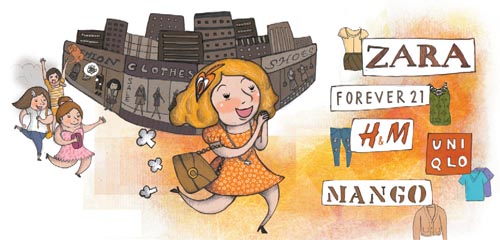 The fast fashion invasion in downtown Myeong-dong has made headlines in recent months, especially since the arrival in late February of Swedish retailer chain H&M. Its entry meant Seoul now has a nearly complete lineup of the top overseas fast fashion brands.
The fast fashion invasion in downtown Myeong-dong has made headlines in recent months, especially since the arrival in late February of Swedish retailer chain H&M. Its entry meant Seoul now has a nearly complete lineup of the top overseas fast fashion brands.
The influx of such brands as Zara and Mango of Spain, Forever 21 of the United States and Uniqlo of Japan and their dazzling success are rapidly reshaping the country’s 27 trillion won ($24.2 billion) fashion retail market and local consumers’ apparel purchasing patterns.
On Monday evening, shoppers crowded the Swedish fashion chain H&M in Myeong-dong. They came from all economic brackets, with some carrying luxury handbags that must have cost several million won to those with obviously fake Louis Vuitton tucked under their arms, all browsing the four-story store spanning almost 30,000 square feet. Standing in the coiled line to check out took at least 10 minutes.
The shop attracts an average of 10,000 customers every weekday and 13,000 to 15,000 on Saturdays and Sundays, according to Cheong Hae-jin, public relations and marketing manager at H&M. Propped up by the brand’s immediate success in Seoul, the Stockholm-based chain announced less than a month after the launch of this store that it would open a second this fall only a few blocks away, and possibly more in other districts.
“We are now convinced that we can offer our Seoul customers added value through fashion and quality at the best price in connection with high design skills at another top downtown location,” said Hans Andersson, H&M’s country manager in Korea, in a statement earlier.
That same Monday night just three subway stops away, small apparel merchants sat in their booths at Good Morning City in Dongdaemun, for decades the center of the Korean-made clothing industry.
About eight of every 10 aisles were deserted. Good Morning City is one of the immense shopping malls scattered across the district, which the Seoul Metropolitan Government still enthusiastically calls the “capital’s biggest fashion town.” Shopkeepers sat idling away the hours. When a customer finally wandered by, one blurted out, “Just take a look. It could never get any cheaper.”
The situation at apM, a building next door to Good Morning City, wasn’t much different. Any customers were Japanese or Chinese tourists, to whom the made-in-Korea label is much more valuable than it is to Koreans.
“Most of the shops here, including mine, sell domestically produced clothes,” said an owner of a female casual clothing store at Good Morning City.
“Look at these fabrics. They are extra-fine quality,” she continued, showing off a colorful flower-pattern dress made from a rayon-cotton blend.
“If you compare them with those made in China and some other mass-producing countries, you can clearly see the difference. But Korean customers keep saying we are expensive, and they don’t give a damn about the country of origin if prices are low,” she complained.
Another woman who runs a casual garments store in Dongdaemun said in frustration that stores in the building couldn’t possibly drag down prices any further, even though she is aware only additional discounts can give them a competitive edge against fast fashion brands. Korea-produced fabric is expensive, and discounts will leave no profit margin at all.
“Already a number of shops have begun placing 5,000 won price tags on T-shirts, risking bankruptcy,” she said.
What’s driven domestic customers away from the Dongdaemun shops they once frequented is a combination of style and cost.
“With that quality design plus that cost, fast fashion apparel has gained legitimate ground to make Dongdaemun ever more unattractive. Now I don’t really feel the need to visit the shopping district,” said In Hye-ran, a 29-year-old office worker.
She once occasionally shopped at Dongdaemun and used to buy Zara or H&M clothes through Internet-based overseas buying agencies. Those Internet agencies impose additional shipping and import charges of tens of thousands of won, but thanks to the arrival of brand stores that purchase the companies’ clothes directly, she can buy the same pieces on a smaller budget.
The price of a chiffon dress or skirt starts at roughly 30,000 won at Dongdaemun, but some cost more than 50,000 won. Price fluctuations are steep across different stores. By comparison, skirts in a similar style cost below 20,000 won at such fast fashion outlets as H&M, Forever 21 and Uniqlo.
As research into their business model has shown, the advantage of these fast fashion brands is their iron grip on the entire vertical process, from design to manufacture and distribution. They outsource the bulk of production to low-cost countries in Asia, or Morocco, Portugal or Turkey. The efficiency of this system and the strategy of keeping stock low and shifting it constantly enable the companies to keep costs down, meaning lower price tags for customers. The technique was pioneered by The Gap in the United States, and was later called SPA, for “speciality store/retailer of private-label apparel.”
Regular manufacturing and rapid replenishment of small batches of new products, added to cheaper prices, enable fast fashion brands to grab increasingly wider demographics. At H&M, for example, new items arrive once a day. The majority of traditional fashion retailers, on the other hand, place orders for seasonal collections months before those lines make an appearance in stores.
“Korean consumers have been quick to recognize the value of fast fashion - being able to buy the trendiest items at all times,” said Kim Hae-ryeon, chief executive of Interfashion Planning, a fashion consulting firm.
Kim Ji-yun, a 32-year-old flight attendant with a national carrier, is one of a large number of consumers who have changed their shopping habits with the dawn of fast fashion retail in recent years. She has begun purchasing items when they come into fashion and dumping them if they get outdated or if she gets tired of them. “I think it’s boring if you wear the same clothes again and again,” she said.
Kim describes herself a practicality-oriented buyer who makes regular business trips due to her job responsibilities and thus has many chances to look around fashion spots in various destinations.
“I used to buy from upscale brands at department stores, but now it feels like the clothes there are overly expensive in comparison to fast fashion brands. I only buy suits from department stores or luxury stores to wear for formal occasions, and those purchases happen only a few times a year.”
Even department stores acknowledge they must adapt to the burgeoning influence of SPA retailers. According to Lee Kyeong-su, assistant manager of public relations at Lotte Department Store, the combined sales of its female casual apparel shops in its main branch - just across the street from the H&M store - have dwindled, though he declined to give detailed figures. The main branch’s Young Plaza wing includes Mango, Zara and Uniqlo branches on three different floors. Lotte has 20 and 50 percent stakes in the local units of Zara and Uniqlo, which entered Korea in 2008 and 2005, respectively.
On a visit to Young Plaza last week, domestic young casual brands such as Soup, Le Shop, St. a and On & On, which shared the second floor with Zara, had up signs announcing discounts of 40 to 70 percent on a sizable portion of their lineups. Some had been up since April. Shopkeepers said the bargain bin products were leftovers from last season but would not specify when the sales would end. The price tags on dresses after the discounts were mostly 49,000 to 60,000 won - figures often found on dresses at Zara.
Lee, the PR manager at Lotte, would not confirm whether the discounts were directly linked to Zara’s high sales. But local casual fashion brands are adopting new strategies in the face of the ever-stronger popularity of fast fashion, he said.
“Instead of lowering price tags, domestic brands are moving to shorten the time it takes them to replace their products and come up with a smaller volume with a wider diversity. They are also placing reorders for those well received by customers,” he said. “Industry insiders say inventories will be visibly reduced by next year.”
For department stores in general, lost sales from fast fashion booths inside the large stores are offset by a larger influx of younger customers there to check out the latest Zara or Uniqlo items. More foot traffic means increased spending elsewhere in the building, in other stores and at the food court.
Some local fashion corporations have gone further, launching their own fast fashion brands to compete. E-Land Group last November launched SPAO, short for “specialty retailer of private-label apparel original.” It then opened a megastore with 2,880 square meters of floor space, right next to a Uniqlo store in Myeong-dong.
Next to try its hand at fast fashion was Fashion Group Hyungji, which opened late last month a gigantic female apparel store under its Crocodile brand in the posh Rodeo Street area in Apgujeong, southern Seoul. The fast fashion brand targets women in their 40s and 50s. The group’s Chairman Choi Byung-oh said in a recent media interview that he believes the expansion of fast fashion across the globe is not a crisis for domestic producers, but an “opportunity.”
“Local garment manufacturers will come under pressure to transform their existing production and sales practices to survive in the competition against overseas brands. It will eventually turn out to be a positive effect for everyone,” Choi said.
Cheil Industries, the country’s largest fashion enterprise, which operates Mango here, has a similar outlook.
“With more reasonably priced fashion items coming in, those consumers who belong to higher purchasing power groups will be moving down to SPA in the longer term,” a spokeswoman with Cheil said.
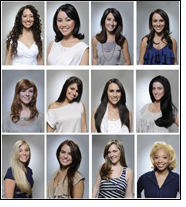 Pantene, the iconic brand known for memorable advertising tag lines such as "don't hate me because I'm beautiful" and "hair so healthy it shines", announced the 12 semi-finalists in the search for the world's first reality hair star. The winner will have the chance to put New Pantene to the ultimate test live in the world's first reality hair ad alongside Pantene's current spokesperson, Stacy London. This game-changing ad will air on May 25, 2010 between 9 and 10PM EDT during a three network roadblock which includes Bravo Media, Oxygen Media and NBC's season finale of "The Biggest Loser: Couples."
Pantene, the iconic brand known for memorable advertising tag lines such as "don't hate me because I'm beautiful" and "hair so healthy it shines", announced the 12 semi-finalists in the search for the world's first reality hair star. The winner will have the chance to put New Pantene to the ultimate test live in the world's first reality hair ad alongside Pantene's current spokesperson, Stacy London. This game-changing ad will air on May 25, 2010 between 9 and 10PM EDT during a three network roadblock which includes Bravo Media, Oxygen Media and NBC's season finale of "The Biggest Loser: Couples."
The follow is a list of the 12 semi-finalists:
Andrea Warner, Age: 32, Hometown: Vancouver, British Columbia
Andrea is a photographer.
"I've been a Pantene user for some time, so I am very excited to be chosen as a semi-finalist to be Pantene's First Reality Hair Star," said Andrea.
Colleen Harju, Age: 23, Hometown: Carver, Massachusetts
Colleen is a licensed esthetician and makeup artist.
"I could be the first Pantene Reality Hair Star," said Colleen. "I have always had beautiful, long, thick hair and now I am ready to make it Pantene fabulous!"
Huda Mumin, Age: 28, Hometown: Oxon Hill, Maryland
Huda works as a chef in the Oxon Hill area.
"I am a loyal Pantene user. I have big hair to go along with my big personality," said Huda. "Pantene has helped my natural beauty to shine."
Kaitlin Voorhest, Age: 20, Hometown: Orlando, Florida
Kaitlin is currently a full-time student.
"I should be Pantene's First Reality Hair Star because my hair is tough to handle, but I work to keep it looking great," said Kaitlin. "My hair is one of my favorite features and I take pride in making it look nice."
Kirsten Norman, Age: 19, Hometown: Pinellas Park, Florida
Kirsten is currently employed at a pizza shop.
"I never thought I would make it this far in the contest," said Kirsten. "I have one dreadlock mixed in with the rest of my hair, so my hair has always been different. I am eager to use the new Pantene to see what it can do to keep my unique look frizz-free and polished."
Lindsay Delgrosso, Age: 18, Hometown: East Amherst, New York
Lindsay is currently a full-time Communication student at Niagara University.
"Pantene's First Reality Hair Star Contest intrigued me and truly challenged my creative abilities," said Lindsay. "What makes my hair Pantene hair is that it is a huge part of who I am, after all isn't that what Pantene hair is all about?"
Marissa Hopson, Age: 24, Hometown: Ft. Lauderdale, Florida
Marissa is currently a full time Broadcast Journalism student.
"I am a huge fan of Pantene," said Marissa. "Pantene makes my hair so soft; I've been using it since I was a kid. I'm excited to put the new collection to the test."
Mercedes Sanchez, Age: 27, Hometown: New York, New York
Mercedes is the founder of BeChicMag.com, an online magazine and lifestyle channel featuring prominent experts in fashion, beauty, and entertainment
"Pantene was the shampoo my family and I used when I was growing up," said Mercedes. "We continue to use Pantene today, and entering the first Reality Hair Star search was only natural for me."
Rachel Guest, Age: 19, Hometown: Oakville, Ontario
Rachel is currently a full-time student studying radio and television broadcasting.
"I am so grateful to be chosen as a semi-finalist in Pantene's search for the First Reality Hair Star – it's surreal," said Rachel. "Not only will I have a chance to be a star, I am one of only two people representing Canada in the contest, which makes it even more exciting!"
Sandy Tran, Age: 20, Hometown: S. San Francisco, California
Sandy is currently a full-time student.
"I've finally learned to embrace the hair that I have and, as a result, embrace my identity and who I am," said Sandy. I should be the world's first Reality Hair Star because I have hair that can be versatile in its styling but is true to its roots."
Sara Schmitt, Age: 24, Hometown: Cedar Rapids, Iowa
Sara works as a personal shopper.
"I am so excited to be chosen as a semi-finalist in Pantene's search for the First Reality Hair Star," said Sara. "Reality stars are dynamic and keep your attention. My hair and personality are a perfect fit."
Valerie Castillo, Age: 28, Hometown: Tulsa, Oklahoma
Valerie is currently a grad student and works as a college recruiter.
"After years of struggling with curls, I've learned to love them with the help of the right products," said Valerie. "I think the new Pantene collection will be a great compliment to my hair and make it look its best."
Each of the 12 semi-finalists received an all-expense paid trip to New York City on May 12, 2010 for an advertising test shoot. Pantene Celebrity Stylist and Global Ambassador, Danilo, was on-hand to provide a style consultation for each of the women. One woman will be selected the ultimate winner and will star in Pantene's live ad with Stacy London.
"I'm really excited to be involved in such a revolutionary project," commented London. "The world's first reality hair star will prove the power of New Pantene on live TV, so make sure to tune in to see what happens!"
With its new understanding of hair's unique inter-fiber relationships, a critical factor in product performance that influences how ingredients work on hair, Pantene reinvented its entire brand structure. New Pantene includes an updated ingredient list, tailored systems, new packaging and new fragrance.
New Pantene solutions are custom created to deliver outstanding product performance based on four unique hair structures and end-benefits. New Pantene utilizes advanced ingredients and customized solutions for Fine, Medium-Thick, Curly, and Color-Treated hair, with shampoos, conditioners, styling products and treatments, including options designed to work together to deliver long-lasting results.
 Hipster clothing chain American Apparel Inc. (APP-A1.55-0.12-7.19%) said Wednesday that its preliminary first-quarter operating loss widened and that it could soon be out of compliance with certain loans and default on its debt.
Hipster clothing chain American Apparel Inc. (APP-A1.55-0.12-7.19%) said Wednesday that its preliminary first-quarter operating loss widened and that it could soon be out of compliance with certain loans and default on its debt.
Its shares sank to a 15-month low.
The company, which was started by Montreal-born retailing executive Dov Charney, did not disclose a net loss or a per-share figure, but said its loss from operations amounted to $17.6-million (U.S.) for the three-month period that ended on March 31. That's far worse than last year's operating loss of $3.9-million.
Net revenue climbed 6.6 per cent to $121.8-million, up from $114.3-million during the same period last year.
Quarterly revenue in stores open at least a year, a key metric for retailers, fell 10 per cent on a constant currency basis. American Apparel operates more than 280 stores in 20 countries.
The Los Angeles clothing maker said it would formally report its first-quarter figures when it submitted a Securities and Exchange Commission filing detailing the numbers some time before the end of June.
Also Wednesday, American Apparel said that by late June it may default on a credit agreement because it will likely be unable to meet a debt-to-earnings ratio required under the terms of the loan.
It's working with a lender to amend the agreement, but cautioned that without a reprieve, there may be a damaging financial chain reaction that could force the company to pay both credit facilities immediately – and in full.
“There can be no assurance that if either or both of these events were to take place, that the company would be able to obtain the additional sources of liquidity required to continue operations,” American Apparel said in a statement.
American Apparel ended its first quarter with $91.4-million in debt, a nearly 11 per cent increase from the $83.4-million in debt it had at the end of 2009.
American Apparel has $36-million and $4-million in cash available under its U.S. and Canadian revolving credit facilities.
Additionally, the retailer said it may be delisted from the Amex for failing to file its quarterly results with regulators on time. The company is working on regaining compliance with continued listing requirements and said it plans to submit its quarterly report as soon as practicable.
 Kate Moss Topshop presents a new collection of vintage inspired signature pieces for Spring Summer 2010. Featuring a handful of limited-edition items and an eclectic mix of eras, styles, fabrics and colour palettes, the core collection truly reflects Kate's bohemian take on dressing and covers every occasion for the season ahead.
Kate Moss Topshop presents a new collection of vintage inspired signature pieces for Spring Summer 2010. Featuring a handful of limited-edition items and an eclectic mix of eras, styles, fabrics and colour palettes, the core collection truly reflects Kate's bohemian take on dressing and covers every occasion for the season ahead.
Topshop and Kate Moss have targeted contemporary designs throughout the range with the new collection taking its inspiration from the 1970s; vintage floral print shirts complete with corseting panels to update a classic.
Dresses dominate the collection, varying from casual summer frocks to elegant daywear through to show-stopping evening gowns. The selection of dresses uses a mix of floral print, sleeved and sleeveless, chiffon tiered as well as 1920s-inspired maxi dresses. The subtle and feminine tones combined with the contemporary approach highlights the diversity in this collection; emphasised by the ditsy print washed cotton mini dress with a maxi length graduated back - the dress of the season. Denim makes a comeback too with a larger selection of shapes and washes. Grey super skinnies, hippy-ish low rise wide leg jeans and a fitted denim blazer are key pieces within the collection.
Topshop is continually recognised as being an authority on women's fashion on clothing such as jeans, dresses and the in-trend maxi dresses having won several awards for design reputation and new services, and has a wide range of clothing from women's jeans and maxi dresses to maternity wear.
Topshop was the first fashion retailer to show on schedule at London Fashion Week in September 2005 when it presented its own acclaimed in-house design collection Unique (created in 2001). Subsequent partnerships with international boutiques as far flung as Tokyo and LA followed and Topshop continues to grow its reputation for supporting exciting new talent.
 The Government of India which had imposed a ban on cotton exports, last month, along with levying an export duty on shipments of the same has now lifted the ban under pressure from farmer lobbyists.
The Government of India which had imposed a ban on cotton exports, last month, along with levying an export duty on shipments of the same has now lifted the ban under pressure from farmer lobbyists.
A notification released by the Commerce Ministry states that, ban on cotton exports on almost all varieties of raw cotton and cotton waste has been lifted, but henceforth, exporters will have to apply for a license.
This decision from the government has come right at a time when cultivation and sowing of cotton is undertaken by the farmers. The ban had come under severe criticism from major cotton producing states like Gujarat and Maharashtra.
In a bid to rein in rising cotton prices which had ascended by 30-35 percent in the last few months, the government had issued a ban on fresh cotton export registrations on April 19 and now just within more than a month; it has now decided to withdraw the ban.
Forget cosmetic surgery. The ancient treatment of acupuncture is gaining new popularity as a beauty secret in Japan about 1,500 years after it first came there from China.
As aesthetic sessions increasingly go organic or employ traditional remedies, women at the "Beauty World Japan" exhibition this week lined up to try acupuncture, long known for its health advantages.
Inserting tiny needles into faces, boosts natural facial healing powers, says therapist Takeshi Kitagawa.
"This is not a medical or surgical procedure," said Kitagawa, acupuncture therapist and owner of Yojo spa.
"We use the healing powers that a person's body naturally possesses, and within the general trend toward a more 'natural beauty' our acupuncture is very well accepted."
Japan is the world's number two market for beauty products and services, with sales estimated at over $15 billion last year alone.
Acupuncturist licensing began during Japan's Meiji Era, about 130 years ago, and Kitagawa says his clients, mainly in their 30s, are increasingly pinning their hopes on the treatment, seeing cosmetics or facelifts as pricey and not as healthy.
"It's different from plastic surgery, it doesn't have the risk of failure. Besides, it uses the innate power of human body to create beauty, and that's the reason I like it," said Rie Hayashida.
Japan has an estimated 40,000 registered acupuncturists and over 150 schools, mainly focused on traditional uses.
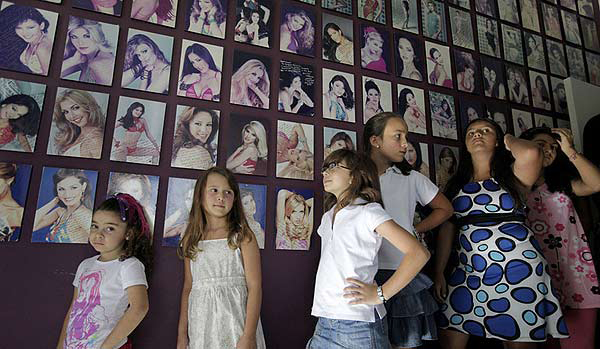 Girls line up before a lesson at a modelling school in Caracas August 27, 2009. Miss Venezuela was crowned Miss Universe last Sunday giving her country its sixth title in the international beauty pageant. It was the second consecutive year that a contestant from the oil-producing South American country, which is famous for its beauty queens, won the Miss Universe title.
Girls line up before a lesson at a modelling school in Caracas August 27, 2009. Miss Venezuela was crowned Miss Universe last Sunday giving her country its sixth title in the international beauty pageant. It was the second consecutive year that a contestant from the oil-producing South American country, which is famous for its beauty queens, won the Miss Universe title.
Girls take a yoga lesson at a modelling school in Caracas August 27, 2009.
A girl has makeup applied on her face at a modelling school in Caracas August 27, 2009.
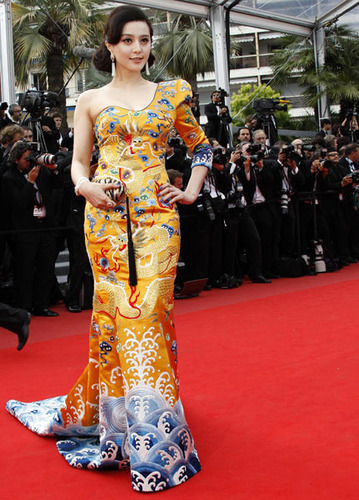 Black hair, slim and elegant figures and perfect smiles are characteristic symbols of Chinese actresses who appear on the red carpets of international film festivals.
Apart from their exclusive oriental temperament, the gorgeous gowns they wear to display Chinese feeling also catch the eyes of global media.
Black hair, slim and elegant figures and perfect smiles are characteristic symbols of Chinese actresses who appear on the red carpets of international film festivals.
Apart from their exclusive oriental temperament, the gorgeous gowns they wear to display Chinese feeling also catch the eyes of global media.
Chinese actress Fan Bingbing poses on the red carpet at the Cannes Film Festival in Cannes, France, May 12, 2010.
Chinese model and actress Lin Zhiling poses on the red carpet at the 61st Cannes Film Festival in Cannes, France, May, 2008.(
Chinese atcress Zhang Ziyi poses on the red carpet.
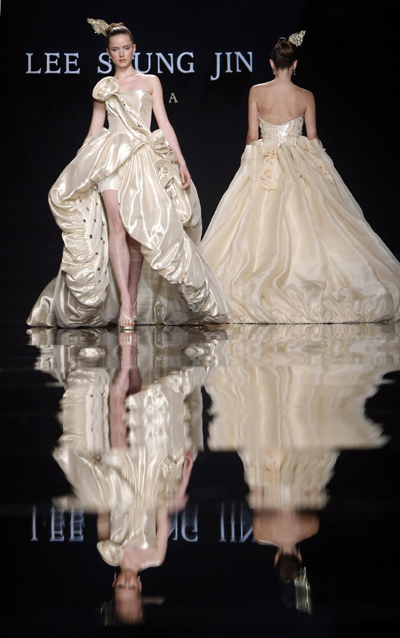 Models present creations from Pepe Botella collection at the Barcelona Bridal Week fashion show May 20, 2010
Models present creations from Pepe Botella collection at the Barcelona Bridal Week fashion show May 20, 2010